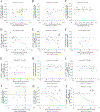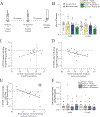The role of beta- and alpha-adrenergic receptors on alcohol drinking
- PMID: 37100382
- PMCID: PMC11071639
- DOI: 10.1016/j.neuropharm.2023.109545
The role of beta- and alpha-adrenergic receptors on alcohol drinking
Abstract
Alcohol Use Disorders (AUD) is characterized by compulsion-like alcohol drinking (CLAD), where intake despite negative consequences can be a major clinical obstacle. With few treatment options available for AUD, there is a significant need for novel therapies. The noradrenergic system is an important hub for regulating stress responses and maladaptive drives for alcohol. Studies have shown that drugs targeting α1 adrenenergic receptors (ARs) may represent a pharmacological treatment for pathological drinking. However, the involvement of β ARs for treating human drinking has received scant investigation, and thus we sought to provide pre-clinical validation for possible AR utility for CLAD by analyzing whether β AR antagonists propranolol (β1/2), betaxolol (β1), and ICI, 118,551 (β2) impacted CLAD and alcohol-only drinking (AOD) in male Wistar rats. We found that the highest dose of propranolol tested systemically (10 mg/kg) reduced alcohol drinking, while 5 mg/kg propranolol reduced drinking with a trend to impact CLAD more than AOD, and with no effects of 2.5 mg/kg. Betaxolol (2.5 mg/kg) also decreased drinking, while ICI 118.551 had no effects. Also, while AR compounds might have utility for AUD, they can also lead to undesirable side effects. Here, a combination of ineffective doses of propranolol and prazosin reduced both CLAD and AOD. Finally, we investigated the effect of propranolol and betaxolol in two brain areas related to pathological drinking, the anterior insula (aINS) and medial prefrontal cortex (mPFC). Surprisingly, propranolol (1-10 μg) in aINS or mPFC did not affect CLAD or AOD. Together, our findings provide new pharmacological insights into noradrenergic regulation of alcohol consumption, which may inform AUD therapy.
Copyright © 2023 Elsevier Ltd. All rights reserved.
Conflict of interest statement
Disclosure
All authors declare no competing interests.
Figures





Similar articles
-
The role of anterior insula-brainstem projections and alpha-1 noradrenergic receptors for compulsion-like and alcohol-only drinking.Neuropsychopharmacology. 2021 Oct;46(11):1918-1926. doi: 10.1038/s41386-021-01071-w. Epub 2021 Jun 24. Neuropsychopharmacology. 2021. PMID: 34168279 Free PMC article.
-
Combining the α1 -adrenergic receptor antagonist, prazosin, with the β-adrenergic receptor antagonist, propranolol, reduces alcohol drinking more effectively than either drug alone.Alcohol Clin Exp Res. 2014 Jun;38(6):1532-9. doi: 10.1111/acer.12441. Epub 2014 May 30. Alcohol Clin Exp Res. 2014. PMID: 24891220 Free PMC article.
-
The Amygdala Noradrenergic System Is Compromised With Alcohol Use Disorder.Biol Psychiatry. 2022 Jun 15;91(12):1008-1018. doi: 10.1016/j.biopsych.2022.02.006. Epub 2022 Apr 13. Biol Psychiatry. 2022. PMID: 35430085 Free PMC article.
-
Animal models of compulsion alcohol drinking: Why we love quinine-resistant intake and what we learned from it.Front Psychiatry. 2023 Mar 24;14:1116901. doi: 10.3389/fpsyt.2023.1116901. eCollection 2023. Front Psychiatry. 2023. PMID: 37032937 Free PMC article. Review.
-
Noradrenergic targets for the treatment of alcohol use disorder.Psychopharmacology (Berl). 2018 Jun;235(6):1625-1634. doi: 10.1007/s00213-018-4843-6. Epub 2018 Feb 20. Psychopharmacology (Berl). 2018. PMID: 29460163 Free PMC article. Review.
Cited by
-
α1 Adrenergic Receptors Mediate Panic-like Defensive Behavior in Alcohol-Drinking but Not Alcohol-Naïve Rats.Pharmaceuticals (Basel). 2025 Mar 28;18(4):484. doi: 10.3390/ph18040484. Pharmaceuticals (Basel). 2025. PMID: 40283921 Free PMC article.
-
GHSR blockade, but not reduction of peripherally circulating ghrelin via β1-adrenergic receptor antagonism, decreases binge-like alcohol drinking in mice.Mol Psychiatry. 2025 Mar;30(3):1047-1056. doi: 10.1038/s41380-024-02713-3. Epub 2024 Sep 5. Mol Psychiatry. 2025. PMID: 39232198 Free PMC article.
-
Greater inhibition of female rat binge alcohol intake by adrenergic receptor blockers using a novel Two-Shot rat binge drinking model.Res Sq [Preprint]. 2024 May 29:rs.3.rs-4402198. doi: 10.21203/rs.3.rs-4402198/v1. Res Sq. 2024. Update in: Sci Rep. 2024 Jun 18;14(1):14029. doi: 10.1038/s41598-024-64565-9. PMID: 38853968 Free PMC article. Updated. Preprint.
-
Sex- and estrous-related response patterns for alcohol depend critically on the level of compulsion-like challenge.Prog Neuropsychopharmacol Biol Psychiatry. 2024 Jul 13;133:111008. doi: 10.1016/j.pnpbp.2024.111008. Epub 2024 Apr 18. Prog Neuropsychopharmacol Biol Psychiatry. 2024. PMID: 38641236 Free PMC article.
-
Greater inhibition of female rat binge alcohol intake by adrenergic receptor blockers using a novel Two-Shot rat binge drinking model.Sci Rep. 2024 Jun 18;14(1):14029. doi: 10.1038/s41598-024-64565-9. Sci Rep. 2024. PMID: 38890353 Free PMC article.
References
-
- Bailly D, Servant D, Blandin N, Beuscart R, Parquet PJ, 1992. Effects of beta-blocking drugs in alcohol withdrawal: a double-blind comparative study with propranolol and diazepam. Biomed Pharmacother 46, 419–424. - PubMed
-
- Barbier E, Barchiesi R, Domi A, Chanthongdee K, Domi E, Augier G, Augier E, Xu L, Adermark L, Heilig M, 2021. Downregulation of Synaptotagmin 1 in the Prelimbic Cortex Drives Alcohol-Associated Behaviors in Rats. Biol Psychiatry 89, 398–406. - PubMed
-
- Carlsson C, Johansson T, 1971. The psychological effects of propranolol in the abstinence phase of chronic alcoholics. Br J Psychiatry 119, 605–606. - PubMed
-
- Carvalho AF, Heilig M, Perez A, Probst C, Rehm J, 2019. Alcohol use disorders. Lancet 394, 781–792. - PubMed
Publication types
MeSH terms
Substances
Grants and funding
LinkOut - more resources
Full Text Sources
Medical
Research Materials

